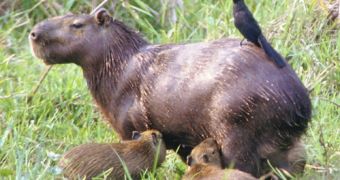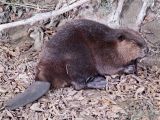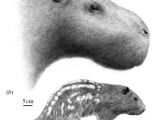South America is the land of the giant rodents. And the biggest of them all is the capybara (Hydrochoerus hydrochaeris). This is the largest living rodent, a relative of agouti, chinchilla, nutria, American porcupine and guinea pig. In many languages, the animal is called "water hog" (this is how hydrochoerus translates from Greek).
An adult capybara may reach 1.3 m (4.3 ft) in length and weigh up to 65 kg (140 lb). Females are larger than males and they can be up to 1 m (3.3 ft) tall. The Capybara inhabits swamp, lake edges and river meadows in all tropical South America. As the animal is semiaquatic, it has slightly webbed feet and the blunt muzzles include the eyes and nostrils, while the ears are on top of the head. The Capybara is tailless and its back legs are slightly longer than the front legs.
These rodents live in groups of 15-20 individuals and they are grazers, preferring soft hygrophilous plants (that thrive in wet or very moist ground). In case of danger, all capybaras enter the water. These animals can dive for a longer period than humans. Usually, they hide under floating grasses, putting only their nostrils out of the water.
Females give birth to 2-3 offspring, which are suckled for months. Capybara meat is tough, that's why the animal is not particularly sought by the hunters. The grease is of better use.
Still, the capybara is a mere dwarf compared to some of its extinct relatives.
One species of rodent from the same South American groups, from the family of the giant hutias, inhabited the islands of Anguilla and St. Martin (in the Lesser Antilles) and weighed up to 200 kg (440 pounds) being as big as an American Black Bear. These hutias could have been hunted to extinction by early settlers of Americas. And even this rodent has been dwarfed by a recent discovery in Uruguay.
Josephoartigasia monesi had a weight of one tonne, being as big as a bison bull, and lived 2 million years ago. Just the skull was 53 cm (1.8 ft) long. The huge "rat" had relatively small teeth, pointing that it could have rather feasted on soft leaves and fruit. The previous largest known rodent was Phoberomys pattersoni, a 700 kg (1,500 pounds), a relative of Josephoartigasia that inhabited Northern Venezuela about 8 million years ago.
The South American fauna of huge rodents emerged as their diversity boomed after the continent split from North America some 55 million years ago, just 10 million years after the extinction of the dinosaurs. It received a lot of primitive mammals that filled the void left by dinosaurs. As rodents did not have to compete with hoofed mammals and face fearsome cats and wolves, they diversified.
However, some 2 million years ago, the two Americas had just reunited once more, and a wave of evolved herbivorous and carnivorous mammals flooded South America, like the saber-toothed cat, deer and tapirs, competing for food and territory with the huge rodents, which subsequently went extinct.
Clime changes could have played their role, as Josephoartigasia was discovered in a now dry area that once was a lush forest. The closest living relative of the Josephoartigasia and Phoberomys is pacarana, a large white stripped rodent (growing up to 15 kg or 33 pounds) from the wet tropical forests of Eastern Andes and western Amazon River basin.
Outside South America, the largest rodent is the beaver (Castor species). Adult beavers are 12-25 kg (maximum 40) (27-55 pounds, maximum 89) heavy, with a head-body length of 60-80 cm (2-2.6 ft) (males are bigger than females). Beavers are the second largest rodents extant, after the South American capybara.
In Pleistocene, 2 million years ago, the extinct beavers Trogontherium (Europe) and Castoroides (North America) were as big as a grizzly bear, having up to 300 kg (670 pounds). They co-existed for a time with the modern genus of beaver, the Castor, that appeared 3 million years ago.

 14 DAY TRIAL //
14 DAY TRIAL // 

